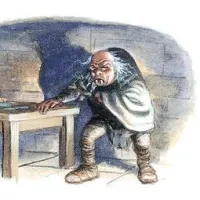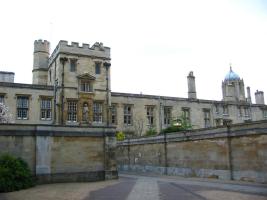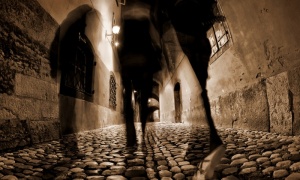Whitby is a town on the North Yorkshire coast that is perched between two supernatural thresholds – the moors and the sea. This area is rich with extraordinary history, stories of the magical and mysterious, of shipwrecks, sailors, superstitions and the supernatural, of wild adventure and impossible happenings. The 17th century abbey here made Whitby one of the key foundations of the early Christian period, and a centre of great learning, though little interfered with the fishing community which scraped together a living on the harbour banks of the River Esk below. For a thousand years, the local herring boats landed their catch until the great whaling boom of the 18th century transformed the fortunes of the town. Melville’s Moby Dick makes much of Whitby whalers like William Scoresby, while James Cook took his first seafaring steps from the town in 1746, on his way to becoming a national hero. Tourism started in Whitby during the Georgian period and developed further on the arrival of the railway in 1839. Its attraction as a tourist destination was enhanced by its proximity to the high ground of the North York Moors National Park, its Heritage Coastline and by its association with the classic horror novel Dracula. There are also stories of a horrific black hound that prowls the streets of Whitby by night, tales of unexplained supernatural phenomena at the Pavilion Theatre and reports of paranormal activity in virtually every room of an historic Georgian manor that is now a guest house during the tourist season.
It was in 1890, while on holiday in Whitby, that Bram Stoker began to become interested in writing a story of vampires and the undead, already popularised in Gothic novels earlier that century. Using first-hand observation of a town he knew well – he stayed at a house on the West Cliff, now marked by a plaque – Stoker built a story which mixed real locations, legend, myth and historical fact. The grounding of Count Dracula’s ship on Tate Hill Sands, for example, was based on an actual event reported in the local papers. The novel was published in 1897 and became synonymous with Stoker’s name; it’s been filmed, with varying degrees of faithfulness, dozens of times since. With many of the early chapters recognisably set in Whitby, it’s hardly surprising that the town has cashed in with the ‘Dracula Experience’ down by the harbourside, which attempts to pull in punters to its rather lame horror-show antics. Keen interest has also been sparked among the Goth fraternity, who now come to town en masse a couple of times a year (usually around the pagan festivals of Beltane and Samhain) for a vampire’s ball, concerts and readings. At these times the streets are overrun with pasty-faced characters in Regency dress, wedding gowns, top hats and capes, meeting and greeting at their unofficial headquarters, the otherwise sedate Elsinore pub on Flowergate.
According to the people of Whitby the most feared of all the town’s myths is that of the legendary Barguest, a wild demon that has taken the form of a hideous black dog. According to Whitby folklore this terrifying hell hound is said to roam the streets, and only those who are going to die soon are able to hear it deathly growl. The Barguest also had other names that were created by the Whitby townsfolk including Padfoot, Gytrash and Scriker. The Barguest is not only a myth that involves Whitby; there is supposedly another ghostly hound found in Trollers Gill near Appletreewick. Amongst the dark caves, winding trees and dirty streams lives something similar to the story that is told by the Whitby townsfolk about the Barguest. It is said to have jet black hair with huge flaming eyes. According to folklore a young boy was not scared by the so called myth of this demon. So one night the young man set off into the Gill with the intent on catching the giant beast. But the morning after his cold broken body was found against the jagged rock, lifeless.
Sitting dramatically on the crest of the East Cliff; Whitby Abbey is a reminder of the power and dominance wielded by the Church in medieval times. The building of Whitby Abbey began in 657 AD, destroyed by the Vikings in 870 AD and then rebuilt after the Norman Conquest in 1067. St Hilda founded the abbey and the legend goes that the saint rid the local area of snakes by chasing them to the edge of the cliffs, striking their heads off with a whip. She also believed that climbing the 199 steps leading up to the abbey was a test of faith. It really isn’t surprising that there is plenty of ghostly activity at Whitby Abbey, the main apparition being St Hilda herself, wrapped in a shroud she has been seen floating in one of the abbey’s highest windows – even Bram Stoker mentions the manifestation in his novel Dracula. Another spectre is a young nun called Constance de Beverley who fell in love with a dashing young knight and broke her vows of chastity. It is said that she was bricked up alive in the walls of the abbey dungeon for her sins, she screamed for mercy until she died. Her ghost is said to haunt the stairs leading from the dungeon where she was imprisoned, still screaming and pleading for forgiveness.
The town has a strong literary tradition; it can even be said that the earliest English literature comes from Whitby as Cædmon, the first known Anglo Saxon poet, was a monk of the order that used Whitby Abbey during the abbacy of St Hilda (657–680). Elizabeth Gaskell set her novel Sylvia’s Lovers partly in the town which she visited in 1859 and Lewis Carroll stayed at 5, East Terrace between July and September 1854: his first publications may have been published in the Whitby Gazette. Wilkie Collins stayed in Whitby to work on his novel, No Name. He was accompanied by Caroline Graves, the inspiration for The Woman in White. G P Taylor, a former Church of England curate in Whitby, is now a celebrated author. His best-selling book Shadowmancer was set in Whitby. The novel Possession by A. S. Byatt, set in the town, was adapted into a 2002 feature film starring Gwyneth Paltrow. A trilogy of young adult novels, The Whitby Witches, makes much of the town’s setting and history, embellishing local traditions whilst incorporating them into the narrative. The author, Robin Jarvis, recalls:
“The first time I visited Whitby, I stepped off the train and knew I was somewhere very special. It was a grey, drizzling day but that only added to the haunting beauty and lonely atmosphere of the place. Listening to Carmina Burana on my headphones, I explored the ruined abbey on the clifftop. The place was a fantastic inspiration. In The Whitby Witches I have interwoven many of the existing local legends, such as the frightening Barguest, whilst inventing a few of my own, most notably the aufwaders.”
Jarvis returned to Whitby for his 2016 novel, The Power of Dark, the first in The Witching Legacy series.

















Constance de Beverley is actually a character in Walter Scott’s poem Marmion. I don’t know of any reference to her dating from before that.